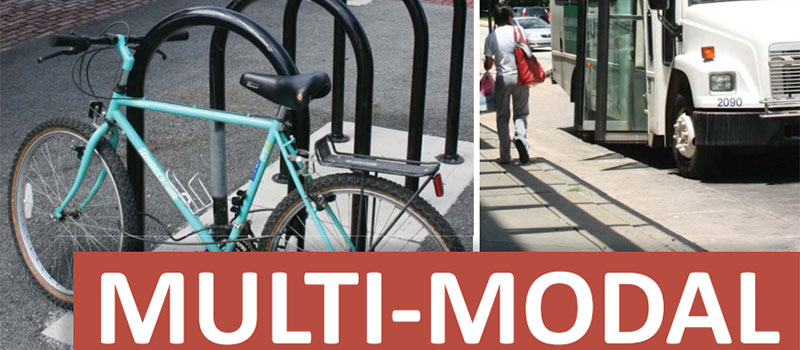Bicycle Parking
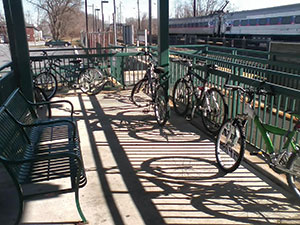
This train platform at the Downingtown Train Station illustrates a need for dedicated bike parking.
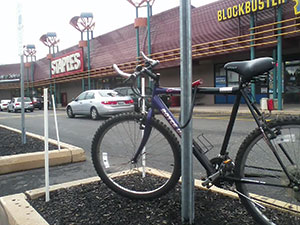
Bikes locked to sign posts at the West Goshen Shopping Center.
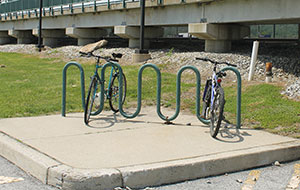
Bicycle rack at Thorndale rail station.
Parking is an essential feature to the accessibility of all land use types. Just like parking a car, people need a safe, secure, and convenient location to store their bicycle once they get to their trip destination. The type of bicycle parking facility is dependent on the type of user and volume of bicyclists. For instance, commuters may prefer covered bicycle parking, such as a bike locker, for added security and to protect their bicycles from the elements for extended lengths of time. Alternatively, someone running errands may be more concerned with ease of access to quickly park and depart the location.
To accommodate recreational bicycling and bicycle mobility, it is essential that communities provide, or facilitate the provision of, secure bicycle parking and/or storage for a bicycle. The image below illustrates the need for bicycle parking at the Downingtown Train Station where bicycles are often locked to fences in a waiting/sitting area because no other option for bicycle parking is provided. There are several options for short-term and long-term bicycle parking and include, but are not limited to, bicycle racks, bicycle stations, and bicycle corrals.
Bicycle Racks
Depending on the type of rack and space dedicated to the parking of bicycles, a bicycle rack can accommodate a few bicycles or a few dozen. Bicycle racks are available in many different designs and configurations that can be customized to any given installation. At a minimum, bicycle racks should be conveniently located, easy to use, and secure.
Bicycle Corrals
Corrals typically have 6 to 12 bicycle racks in a row and can park 10 to 20 bicycles using space otherwise occupied by one to two cars. Bike corrals remove the bicycle (and rider) from the sidewalk and away from potential conflicts with pedestrians using the sidewalk. Several bike corrals have been installed in the City of Philadelphia where the demand is high for bicycle parking as shown in the following image.
Bicycle Stations
Amenities can include changing facilities, day use lockers, parts and other gear available for purchase, repair services, air inflation stations, and information. Cyclists can purchase a membership to access their bicycles anytime, day or night. The bike station pictured below is located in Washington D.C. and the membership fee averages around $100 per year.
Recommendations
Municipalities should include requirements for bicycle parking in their zoning / subdivision & land development ordinances. Bicycle parking should be targeted to the following land uses:
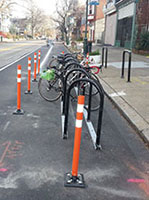
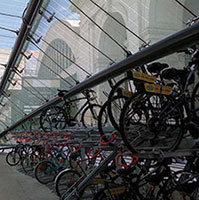
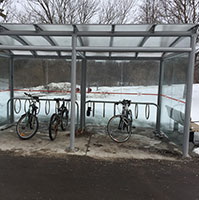
TA bicycle corral at Walnut and South Sydenham Streets,Philadelphia; A bike station in Washington D.C. (Photo Courtesy of Mobis Transportation Alternatives); A bike station in Ottawa, Ontario, Canada. (Photo by John Calnan of SEPTA)
- Institutional (libraries, schools, government offices)
- Retail centers
- Employment centers
- Recreational uses (parks and trails)
- Rail stations
- Transportation centers
There are a number of ways to incorporate bicycle parking into ordinances. Ordinances can require a certain amount of parking spaces be dedicated to bicycle parking though the installation of bike racks. Ordinance standards can also require or encourage the installation of bike racks near the entrance to a business or use on a public sidewalk where appropriate accommodations can be made. This can be accomplished through off street parking requirements, streetscape requirements, or incentives.
The following are recommended guidelines towards the establishment of a bicycle parking ordinance:
- Bicycle racks should be required based on the density or intensity of a proposed residential, institutional, commercial, or industrial use. For example, one (1) bicycle rack that accommodates a minimum of ten (10) bicycles shall be required for every fifty-thousand (50,000) square feet of gross leasable floor area or fifty (50) or more multi-family dwelling units. The municipality can adjust the "thresholds" to meet their community objectives or the intent of the associated zoning district.
- Bicycle racks should be permanently anchored to promote stability and security, unless the racks are portable in which case they should be securely locked to a permanent structure.
- Bicycle racks should be located in visible areas near building entrances and/or areas of pedestrian activity such as: courtyards, bus shelters, etc.
- Bicycle racks should be located under a shelter or a building overhang or inset to provide shelter from the elements for bicycles and riders.
- Where no designated area for bicycle racks is feasible, perhaps in the case of a change in use, automobile parking space(s) can be dedicated to bicycle parking through the use of portable bicycle racks.
| Land Use | Number of Bicycle Parking Spaces |
|---|---|
| Multi-family Residential | 10 spaces for every 50 or more dwelling units |
| Insitutional, Commercial, or Industrial | 10 spaces for every 50,000 SF Gross Floor Area |
Other means by which to provide for more bicycle parking include:
- Encourage businesses to place bike racks at existing facilities; and,
- Ask businesses / business associations to donate money for bicycle parking or to sponsor bicycle parking for placement by the municipality.


